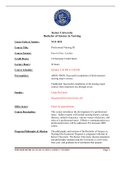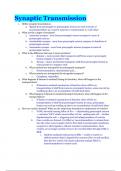Study guide
Pain Elective - Problem 1 & 2; Lecture 1, 2, 3
- Instelling
- Erasmus Universiteit Rotterdam (EUR)
This is a summary of Problems 1, 2, and lectures 1-3 from the elective Pain during third year of Psychology at EUR. It is really concise and I hope it helps you as much as it helped me! I recommend also taking a look at the diagrams available in the articles, as they are very useful :)
[Meer zien]













